News
MIT Lincoln Laboratory recognizes staff members’ exceptional technical achievements
Daniel O’Connor and Joseph Scozzafava are the 2015 recipients of the esteemed Technical Excellence Awards
On 26 February at a ceremony held in Lincoln Laboratory's auditorium, awards for Technical Excellence, Early Career Technical Achievement, Best Paper, and Best Invention were presented to the 2015 recipients. Four individuals and three teams were recognized for their outstanding contributions to both the Laboratory's technology development programs and their technical fields.
Technical Excellence Awards
Dr. Daniel A. O’Connor, leader of the Ballistic Missile Defense System Integration Group, and Joseph J. Scozzafava, leader of the Mechanical Engineering Group, were presented with 2015 MIT Lincoln Laboratory Technical Excellence Awards. One of the most prestigious awards the Laboratory bestows on staff members, the Technical Excellence Award was established in 2001 to recognize "exceptional, sustained, technical work that has made a significant impact on a Laboratory mission area." Each year's two honorees, in addition to their personal prizes, are granted authority over an account that they can use to enhance their research environment.
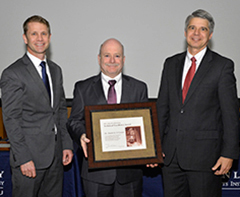 |
 |
| Left photo: Daniel O’Connor, center, is shown with Justin Brooke, left, head of the Air, Missile, and Maritime Defense Technology Division, who introduced Dr. O’Connor at the ceremony, and Eric Evans, director of Lincoln Laboratory, who presented Dr. O’Connor with his award. Right photo: Joseph Scozzafava, center, is shown with Michael Languirand, left, head of the Engineering Division, who introduced Mr. Scozzafava, and Director Evans, who presented Mr. Scozzafava’s award. (Photos: Jon Barron) |
|
Dr. O'Connor was honored for "his outstanding technical contributions to the field of ballistic missile defense (BMD), creativity in developing and demonstrating techniques for BMD, and leadership in initiating a major national effort in discrimination technology." Since joining the Laboratory in 1982, he has conducted research on tracking, discrimination, and defense system architectures. His initial work involved systems analysis for strategic missile defense. He served a two-year tour at the Reagan Test Site on the Kwajalein Atoll, Marshall Islands, as a system engineer for the Target Resolution and Discrimination Experiment (TRADEX) radar. After his return to the main Lincoln Laboratory site in Lexington, Massachusetts, he worked on the Theater Missile Defense Critical Measurements Program, focusing on the analysis of radar and electro-optic observables and the development of discrimination techniques. He also supported the Aegis Advanced Technology Program, developing radar algorithms for regional missile defense.
From 2000 to 2009, Dr. O'Connor led Lincoln Laboratory's efforts that supported Project Hercules, a Missile Defense Agency program to develop and test advanced sensor decision-making algorithms. Dr. O'Connor currently directs development programs to integrate BMD sensors, weapons, and battle management centers. He plans to use the award's research grant to conduct further collaborative work in BMD systems: "I am pleased and honored to receive the Technical Excellence Award and will use it to help our young staff expand their research opportunities."
Mr. Scozzafava received his award for "his leadership and creativity in developing laser communications technology, significant contributions to solving critical mechanical issues on major space payload and radar developments, and innovative work on mechanical rotary interface and electro-optical devices. Over his more than 30 years at Lincoln Laboratory, he has worked on a wide variety of technologies—large ground-based and sea-based radars, unique airborne sensors and communication systems, and optical space payloads, including free-space optical communication systems. His early work in optical communications at the Laboratory involved planning the integration and test efforts for the Geosynchronous Lightweight Integrated Technology Experiment, a demonstration of the world's first successful space-based high-rate optical communication system.
Mr. Scozzafava has contributed significantly to several large NASA development programs, including the Lunar Laser Communication Demonstration (LLCD), for which he developed the initial mechanical design concept for a compact, low-mass, low-power inertially stabilized optical terminal that was foundational to the LLCD system. This system used optical communications to transmit data from a lunar orbiting terminal to a terminal on Earth's surface at a record-breaking download speed of 622 megabits per second. Currently, he is focusing on advancing his group's capabilities in precision engineering, optomechanical engineering, and system fabrication. On his selection for a Technical Excellence Award, he says, "I’ve worked with several previous recipients who are some of the most talented engineers I've ever encountered. To become part of this group is a great honor."
Early Career Technical Achievement Awards
The 2015 Early Career Technical Achievement Awards, which recognize significant technical contributions by individuals under the age of 35, were presented to Dr. Bow-Nan Cheng, a member of the technical staff in the Tactical Networks Group, and Dr. Francesca D. D'Arcangelo, a member of the technical staff in the Homeland Protection Systems Group.
 |
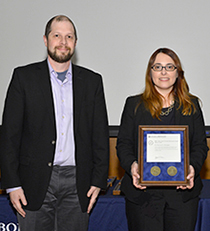 |
| Left photo: Bow-Nan Cheng, left, is shown with Aradhana Narula-Tam, assistant leader of the Tactical Networks Group, who gave the introduction for Dr. Cheng’s award at the technical awards ceremony. Right photo: Francesca D’Arcangelo, right, is shown with Michael Watson, assistant leader of the Homeland Protection Systems Group, who gave the introduction for Dr. D’Arcangelo’s award. (Photos: Jon Barron) |
|
Dr. Cheng has performed influential work in the development, understanding, and standardization of radio-to-router interface technology as a means to separate radio and router functionality and to allow greater interoperability among systems. His approach for this interface technology has been adopted by several Department of Defense and commercial radio manufacturers, as well as by large commercial router manufacturers. Dr. Cheng has also led rapid development efforts to implement a Link-16 surrogate waveform on a chip, to design and implement Internet protocol (IP) header compression schemes, and to architect and build a high-capacity aerial IP backbone network. As a graduate student at Rensselaer Polytechnic Institute, he conducted researched into wireless networking, earning master's and doctoral degrees in computer systems engineering. Since then, he has authored more than 45 refereed conference and journal papers on communications technology.
Dr. D'Arcangelo was recognized for her broad systems analysis expertise, which has significantly enriched Lincoln Laboratory's work in developing technology for countering unmanned aircraft systems, detecting biological threats, studying the impacts of radar clutter on maritime security, and modeling atmospheric conditions affecting optical systems in maritime environments. She was instrumental in helping the U.S. Coast Guard (USCG) respond to the Deepwater Horizon oil spill in the Gulf of Mexico, leading an analysis to advise the USCG's deployment of aircraft that provided surveillance necessary for directing the cleanup vessels to oil-threatened waters. She has also supported the USCG with a variety of analyses that informed decisions on such issues as security for small vessels in port and architectures for systems used in remote sensing operations. Dr. D'Arcangelo, who holds a doctoral degree in astronomy from Boston University, is currently researching systems that can sense and respond to the increasing number of unmanned aircraft flying in the national airspace.
Best Paper Awards
The MIT Lincoln Laboratory Best Paper Award annually recognizes an outstanding paper published by Laboratory researchers in either a peer-reviewed journal or peer-selected conference publication. For 2015, two papers were named winners of this award.
Dr. Timothy M. Yarnall, Dr. David J. Geisler, Mark L. Stevens, Dr. Curt M. Schieler, Dr. Bryan S. Robinson, and Dr. Scott A. Hamilton of Lincoln Laboratory's Optical Communications Technology Group authored the paper "Multi-Aperture Digital Coherent Combining for Next-Generation Optical Communication Receivers," which was selected as a 2015 recipient for its clear discussion of coherent techniques that significantly improve the sensitivity of a high-speed space-ground optical link. The authors demonstrate that coherent combining of multiple signals can be implemented digitally with no penalty, despite phase and intensity changes that occur on millisecond time scales. The results described in this paper presented at the 2015 IEEE International Conference on Space Optical Systems may presage much-lower-cost space-ground links.
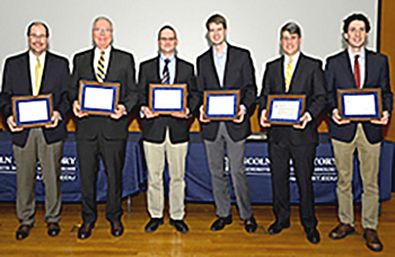 |
|
| Shown with their Best Paper Award plaques are the authors of "Multi-Aperture Digital Coherent Combining for Next-Generation Optical Communication Receivers": from left to right, Scott Hamilton, Mark Stevens, Bryan Robinson, Curt Schieler, Timothy Yarnall, and David Geisler. (Photo: Jon Barron)
|
|
Dr. Danielle A. Braje of the Laboratory's Quantum Information and Integrated Nanosystems Group and colleagues from MIT—Hannah A. Clevenson, Matthew E. Trusheim, Carson A. Teale, Dr. Tim Schröder, and Prof. Dirk R. Englund—received a Best Paper Award for "Broadband Magnetometry and Temperature Sensing with a Light-Trapping Diamond Waveguide," which was published in the April edition of Nature Physics Letters. This well-written paper describes a novel light-trapping diamond waveguide geometry. Using optically detected magnetic resonance, the authors demonstrate orders of magnitude improvement in the magnetic field sensitivity of nitrogen-vacancy color centers. The work could significantly impact the building of small magnetometers, inertial sensors, and clocks.
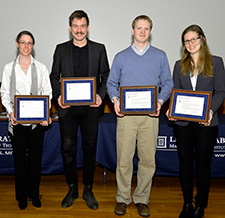 |
Shown with their Best Paper Award plaques are some of the authors of "Broadband Magnetometry and Temperature Sensing with a Light-Trapping Diamond Waveguide": from left to right, Danielle Braje, Tim Schröder, Matthew Trusheim, and Hannah Clevenson. Unable to attend the awards ceremony were Carson Teale and Dirk Englund. (Photo: Jon Barron) |
Best Invention Award
The Best Invention Award is presented each year to Lincoln Laboratory researchers who have developed a new device, method, or process. Typically, winners have been inventions for which a technology disclosure, patent application, or patent license has been filed. The 2015 Best Invention is Rapid and Precise Optically Multiplexed Imaging, developed by Dr. Yaron Rachlin and Vinay N. Shah of the Space Systems and Technology Division and Dr. Tina Shih and Dr. R. Hamilton Shepard of the Engineering Division. This new method to trade dynamic range for field of view uses a single imager where many imagers were used in previous system designs. This technique results in lower size, weight, power, and cost for an imaging system.
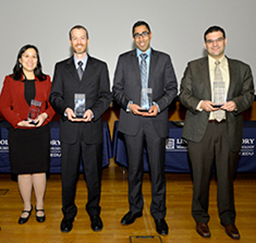 |
The inventors of Rapid and Precise Optically Multiplexed Imaging received Best Invention trophies. Seen here left to right are Tina Shih, Hamilton Shepard, Vinay Shah, and Yaron Rachlin. (Photo: Jon Barron) |
The Technical Excellence Award was established in 2001 to honor individuals' sustained distinction in their fields and their commitment to the Laboratory's mission of technology in support of national security. In 2009, the Best Paper and Best Invention Awards were inaugurated, and in 2010, the Director's Office created the Early Career Technical Achievement Award to recognize the accomplishments of younger staff members.
Posted March 2016
top of page